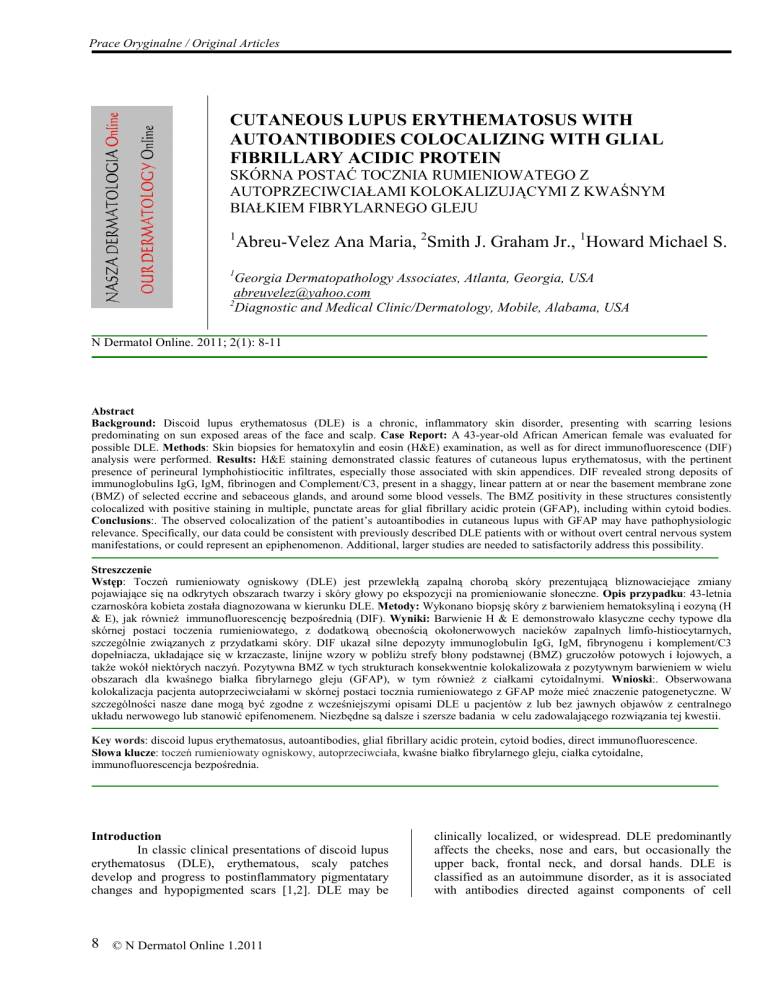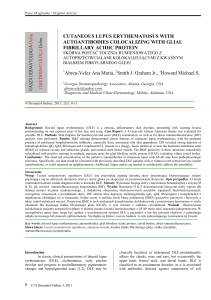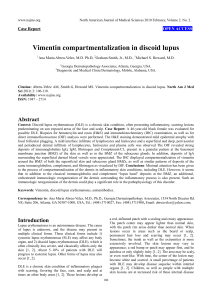Cutaneous lupus with ab cololizing with GFAP
advertisement

Prace Oryginalne / Original Articles CUTANEOUS LUPUS ERYTHEMATOSUS WITH AUTOANTIBODIES COLOCALIZING WITH GLIAL FIBRILLARY ACIDIC PROTEIN SKÓRNA POSTAĆ TOCZNIA RUMIENIOWATEGO Z AUTOPRZECIWCIAŁAMI KOLOKALIZUJĄCYMI Z KWAŚNYM BIAŁKIEM FIBRYLARNEGO GLEJU 1 Abreu-Velez Ana Maria, 2Smith J. Graham Jr., 1Howard Michael S. 1 Georgia Dermatopathology Associates, Atlanta, Georgia, USA abreuvelez@yahoo.com 2 Diagnostic and Medical Clinic/Dermatology, Mobile, Alabama, USA N Dermatol Online. 2011; 2(1): 8-11 Abstract Background: Discoid lupus erythematosus (DLE) is a chronic, inflammatory skin disorder, presenting with scarring lesions predominating on sun exposed areas of the face and scalp. Case Report: A 43-year-old African American female was evaluated for possible DLE. Methods: Skin biopsies for hematoxylin and eosin (H&E) examination, as well as for direct immunofluorescence (DIF) analysis were performed. Results: H&E staining demonstrated classic features of cutaneous lupus erythematosus, with the pertinent presence of perineural lymphohistiocitic infiltrates, especially those associated with skin appendices. DIF revealed strong deposits of immunoglobulins IgG, IgM, fibrinogen and Complement/C3, present in a shaggy, linear pattern at or near the basement membrane zone (BMZ) of selected eccrine and sebaceous glands, and around some blood vessels. The BMZ positivity in these structures consistently colocalized with positive staining in multiple, punctate areas for glial fibrillary acidic protein (GFAP), including within cytoid bodies. Conclusions:. The observed colocalization of the patient’s autoantibodies in cutaneous lupus with GFAP may have pathophysiologic relevance. Specifically, our data could be consistent with previously described DLE patients with or without overt central nervous system manifestations, or could represent an epiphenomenon. Additional, larger studies are needed to satisfactorily address this possibility. Streszczenie Wstęp: Toczeń rumieniowaty ogniskowy (DLE) jest przewlekłą zapalną chorobą skóry prezentującą bliznowaciejące zmiany pojawiające się na odkrytych obszarach twarzy i skóry głowy po ekspozycji na promieniowanie słoneczne. Opis przypadku: 43-letnia czarnoskóra kobieta została diagnozowana w kierunku DLE. Metody: Wykonano biopsję skóry z barwieniem hematoksyliną i eozyną (H & E), jak równieŜ immunofluorescencję bezpośrednią (DIF). Wyniki: Barwienie H & E demonstrowało klasyczne cechy typowe dla skórnej postaci toczenia rumieniowatego, z dodatkową obecnością okołonerwowych nacieków zapalnych limfo-histiocytarnych, szczególnie związanych z przydatkami skóry. DIF ukazał silne depozyty immunoglobulin IgG, IgM, fibrynogenu i komplement/C3 dopełniacza, układające się w krzaczaste, linijne wzory w pobliŜu strefy błony podstawnej (BMZ) gruczołów potowych i łojowych, a takŜe wokół niektórych naczyń. Pozytywna BMZ w tych strukturach konsekwentnie kolokalizowała z pozytywnym barwieniem w wielu obszarach dla kwaśnego białka fibrylarnego gleju (GFAP), w tym równieŜ z ciałkami cytoidalnymi. Wnioski:. Obserwowana kolokalizacja pacjenta autoprzeciwciałami w skórnej postaci tocznia rumieniowatego z GFAP moŜe mieć znaczenie patogenetyczne. W szczególności nasze dane mogą być zgodne z wcześniejszymi opisami DLE u pacjentów z lub bez jawnych objawów z centralnego układu nerwowego lub stanowić epifenomenem. Niezbędne są dalsze i szersze badania w celu zadowalającego rozwiązania tej kwestii. Key words: discoid lupus erythematosus, autoantibodies, glial fibrillary acidic protein, cytoid bodies, direct immunofluorescence. Słowa klucze: toczeń rumieniowaty ogniskowy, autoprzeciwciała, kwaśne białko fibrylarnego gleju, ciałka cytoidalne, immunofluorescencja bezpośrednia. Introduction In classic clinical presentations of discoid lupus erythematosus (DLE), erythematous, scaly patches develop and progress to postinflammatory pigmentatary changes and hypopigmented scars [1,2]. DLE may be 8 © N Dermatol Online 1.2011 clinically localized, or widespread. DLE predominantly affects the cheeks, nose and ears, but occasionally the upper back, frontal neck, and dorsal hands. DLE is classified as an autoimmune disorder, as it is associated with antibodies directed against components of cell nuclei. [1,2]. DLE may affect any tissue, but in this article we describe the skin manifestations of the disorder; these are often elicited by sun exposure. DLE tends to be more clinically severe in smokers [1,2]. Multiple variants of cutaneous LE exist, including DLE, subacute LE, tumid LE, neonatal LE, chilblain LE, druginduced LE, systemic lupus erythematosus, and hypertrophic LE, among others [1,2]. Rarely, discoid LE occurs on the palms and/or soles (palmoplantar LE). If the hair follicles are involved, they are first plugged with adherent scale; subsequently, bald areas develop. If hair follicles are destroyed, the bald patches become permanent (scarring alopecia). DLE may affect the lips and interior of the mouth, eliciting scaling and ulcers [1,2]. Case Report A 43-year-old African American female presented with clinical lesions consistent with DLE. She denied systemic symptoms of arthralgia, arthropathy, myalgia, fatigue, Raynaud's phenomenon and gastrointestinal complaints. Lesions were present on the head, predominately on the cheeks; truncal lesions were also present. The lesions presented as reddish-purple, atrophic plaques. Laboratory data demonstrated a normal complete blood count (CBC) with differential analysis, and a normal erythrocyte sedimentation rate. Antiphospholipid antibody testing was negative; serum electrolytes, blood urea nitrogen, creatinine, and liver function tests, as well as urinalysis and chest radiographs were within normal limits. The antinuclear antibody (ANA) titer was normal. Specific ANA screening yielded negative results for anti-Smith, anti-double stranded DNA (dsDNA), and anti-histone antibodies. Tests for anti-ribonuclease-sensitive antigen (RNAse), extractable nuclear antigen (ENA), small nuclear antigen (SNA), ribonucleoproteins (RNP), and U1 and U2 complexes were negative, as was testing for anti-SS-A (anti-Ro) and anti-SS-B (anti-La) antibodies. Levels of Complement/C3 and C4 were normal. Biopsies of the skin lesions were obtained, with hematoxylin and eosin (H&E) staining and additional multicolor direct immunofluorescence (DIF), performed as previously described [3-5]. H & E: Examination of the H&E tissue sections revealed mild epidermal atrophy with focal follicular plugging. A mild interface infiltrate of lymphocytes and histiocytes was noted. Focal cytoid bodies were appreciated at the BMZ. Within the dermis, a superficial and deep, perivascular and periadnexal infiltrate of lymphocytes, histiocytes, and plasma cells was observed. Neutrophils and eosinophils were rare. A PAS special stain demonstrated no fungal organisms, and accentuation 1) at the BMZ of the epidermal junctional zone, and 2) around dermal eccrine glands, blood vessels and nerves. previously reported techniques [3-5]. The secondary antibodies were of rabbit origin, and included: a) antihuman IgG (γ chain), b) anti-human IgA (α chains), c) anti-human IgM (µ-chain), d) anti-human fibrinogen, and e) anti-human albumin (all used at 1:20 to 1:60 dilutions and obtained from Dako (Carpinteria, California, USA). We also utilized secondary antibodies of goat origin, including: a) anti-human IgE antiserum (Vector Laboratories, Bridgeport, New Jersey, USA) and b) antihuman Complement/C1q (Southern Biotech, Birmingham, Alabama, USA). Finally, FITC conjugated monoclonal anti-human IgG4 antibody was used to test for possible intercellular staining between keratinocytes (Sigma-Aldrich Saint Louis, Missouri, USA). The slides were then counterstained with 4',6-diamidino-2phenylindole (Dapi) (Pierce, Rockford, Illinois, USA). Slides were then washed, coverslipped, and dried overnight at 4oC. For colocalization of antibodies, we used Cy3 conjugated monoclonal mouse anti-human antibody anti-glial fibrillary acidic protein (GFAP) (Sigma-Aldrich). In Figure 1, we demonstrate some of the most prominent H&E and DIF patterns observed, as well as the improvement of the quality and power of DIF staining via simultaneous multicolor fluorescence and counterstaining of cell nuclei. The DIF results were classified as follows: (0, negative; +, weak positive; ++ and +++, positive; and ++++, maximum positive). The following results were obtained: IgG (++++, linear BMZ); IgG4(-); IgA (++++, linear BMZ); IgM (++++, linear BMZ); IgD(-); IgE(-); Complement/C1q(-); Complement/C3 (++, linear BMZ); GFAP(++++, linear and colocalized in areas where most of the deposits of IgG, IgM, and fibrinogen were found, including an association with cytoid bodies) (see Figure 1). The control biopsy showed no GFAP staining at the BMZ); albumin (++++, linear BMZ); and fibrinogen (++++, linear BMZ). Discussion Similar to many other dermatoses, DLE often presents in a bilateral, symmetric lesional pattern [1,2]. However, DLE has not been classically associated with an immune response colocalizing with neural antigens; in addition, the disease is often exacerbated by stress and/or sunlight. In our results, we demonstrate by H&E, PAS and DIF evidence of autoreactivity at BMZs of the skin junctional zone and cutaneous appendages with multiple antibodies, including IgG, IgM, Complement/C3, fibrinogen and albumin. We also detected colocalization of patient autoantibodies with GFAP at in these areas, as well as within cytoid bodies. Our data may indicate that GFAP antigens may play a pathophysiologic role in DLE, as previously documented in patients with systemic lupus erythematosus. DIF: In brief, skin cryosections were prepared, and incubated with multiple fluorescein isothiocyanate (FITC)-conjugated secondary antibodies, utilizing © N Dermatol Online 1.2011 9 Figure 1:1a. PAS positivity around the hair follicle (blue arrows), the sweat glands (red arrows) and blood vessels (green arrows). b. H&E showing positive reinforcement around the sebaceous glands (blue arrows). c. H & E staining reveals some separation of the BMZ of the hair follicle (blue arrow). d. H & E staining demonstrates strong lymphohistiocytic infiltration around some nerves, in proximity to eccrine and sebaceous glands (blue arrows). e. Clinical photograph showing erythematoous, hyperpigmented plaques with some areas of atrophy in bilateral malar areas (blue arrows). f DIF displaying positive staining with FITC conjugated anti-human fibrinogen against the BMZ of the dermal-epidermal junction, and the sebaceous glands (green staining, red arrows). Note the patient autoantibodies colocalize with positive staining for GFAP (white staining, blue arrows). The nuclei are counterstained with Dapi (light blue). g. DIF demonstrating positive staining with FITC conjugated anti-human IgM against the BMZ of the dermal-epidermal junction, and also on cytoid bodies (green-yellowish staining, red arrows). Note the patient autoantibodies colocalized with positive staining for GFAP (white staining, blue arrows). h. DIF demonstrating positive staining with FITC conjugated anti-human IgG against the BMZ of the sebaceous glands (green-yellow staining, red arrows). Note the patient autoantibodies colocalized with positive staining for GFAP (white staining, yellow arrows). i. DIF showing positive staining with FITC conjugated antihuman IgM against the neurovascular plexus supply of the sebaceous glands (green-yellowish staining, red arrows). Note the patient autoantibodies colocalized with positive staining for GFAP (white staining, yellow arrows). 10 © N Dermatol Online 1.2011 Specifically, previous authors investigated groups of patients with SLE (with and without overt central nervous system (CNS) manifestations) to detect possible correlation between clinical parameters and a large panel of antibodies, including ones reactive against neurotypic and gliotypic antigens. The patients with SLE were investigated in a cross-sectional study which included clinical evaluation of symptoms, cerebral magnetic resonance imaging (MRI) and brain single photon emission tomography (SPECT) analysis, electroencephalography (EEG), and serological tests for antibodies directed against nuclear, cytoplasmic, neuronal and glial cell-related antigens. The study results revealed a significant positive association of GFAP colocalization of patient serum autoantibodies with 1) neuropsychiatric (NP) manifestations, 2) antiserin proteinase 3 (anti-PR3/c-ANCA) serum antibodies and 3) pathological cerebral SPECT data. The data included significantly higher values of the organ damage index in patients with abnormal MRIs, and 2) abnormal SPECT and MRI results [7,8]. The authors concluded that neuropsychiatric manifestations, namely those of the organic/major type, appeared to be significantly associated with the presence of a serum autoantibody against GFAP, a gliotypic antigen. Further, brain imaging by MRI and SPECT in SLE patients appears to detect CNS involvement significantly related to specific categories of NP manifestations. The abnormalities detected by the two tests seem to be preferentially associated with different activity phases of the NP disorder, and/or the lupus disease process [6,7,8]. In a different study, investigators analyzed all antigens reacting strongly with autoantibodies in a lupus patient's serum, utilizing 1) proteonomic analyses and two-dimensional electrophoresis (2DE), followed by 2) Western blotting and liquid chromatography-tandem mass spectrometry(using rat brain proteins as the antigen source). In their results, these authors identified four relevant antigens: beta-actin, alpha-internexin, 60 kDa heat-shock protein (Hsp60) and GFAP. In addition, several reports exist regarding detection of antiendothelial cell antibodies (AECAs) in SLE patients. Recently, one of the antigens reacting with AECAs in SLE patient sera has been identified as human Hsp60. The authors suggested that their abnormal findings on brain MRI images could be caused by impairment of microcirculation associated with vascular endothelial cell injury, and mediated by the antibody against Hsp60 [9]. Another relevant case involves data from the eyes at autopsy in a 26-year-old female patient diagnosed with SLE and peripheral neuropathy. The patient had no significant ocular problems. However, the histopathologic findings in the eyes included capillary lumen obliteration; these areas further demonstrated IgG, which was also detected throughout the choroid plexus arterioles [10]. Compared to the control, the connective tissue sheaths of the central retinal vessels displayed a large number of proliferated fibroblast cells, and Masson Trichrome staining revealed transmural vessel scarring; strong GFAP immunoreactivity was further observed surrounding the vessel wall. The authors suggested that these pathological changes were due to impaired blood circulation, specifically caused, hemorrhage, vasculitis and fibrinous vessel occlusion. The changes observed suggested that regular, thorough ophthalmic examinations should be conducted in SLE patients, even in the absence of significant ocular symptoms [10]. We thus conclude that patients with DLE could indeed have autoantibodies to GFAP, as seen in patients with SLE exhibiting discrete central nervous system and NP manifestations. Further, larger studies are needed to further confirm this pathophysiologic possibility. Acknowledgments: Jonathan S. Jones HT(ASCP), and Lynn K. Nabers HT, HTL(ASCP) at GDA for excellent technical assistance. REFERENCES / PIŚMIENNICTWO: 1. Walling HW, Sontheimer RD: Cutaneous lupus erythematosus: issues in diagnosis and treatment. Am J Clin Dermatol 2009; 10: 365-381. 2. Sepehr A, Wenson S, Tahan SR: Histopathologic manifestations of systemic diseases: the example of cutaneous lupus erythematosus. J Cutan Pathol. 2010; 37: 112-124. 3. Abreu Velez AM, Howard MS, Loebl AM: Autoreactivity to sweat and sebaceous glands and skin homing T cells in lupus profundus. Clin Immunol. 2009; 132: 420-424. 4. Abreu Velez AM, Smith JG Jr, Howard MS: Vimentin compartamentalization in discoid lupus. North Am J Med Sci. 2010; 2: 106-110. 5. Abreu Velez AM, Girard JG, Howard MS: Antigen presenting cells in a patient with hair loss of and systemic lupus erythematosus. North Am J Med Sci. 2009; 1: 205210. 6. Sanna G, Piga M, Terryberry JW, Peltz MT, Giagheddu S, Satta L, et al: Central nervous system involvement in systemic lupus erythematosus: cerebral imaging and serological profile in patients with and without overt neuropsychiatric manifestations. Lupus. 2000; 9: 573-583. 7. Senécal JL, Raymond Y: The pathogenesis of neuropsychiatric manifestations in systemic lupus erythematosus: a disease in search of autoantibodies, or autoantibodies in search of a disease? J Rheumatol 2004; 31: 2093-2098. 8. Colasanti T, Delunardo F, Margutti P, Vacirca D, Piro E, Siracusano A, et al: Autoantibodies involved in neuropsychiatric manifestations associated with systemic lupus erythematosus. J Neuroimmunol. 2009; 25; 212-219. 9. Kimura A, Sakurai T, Tanaka Y, Hozumi I, Takahashi K, Takemura M, et al: Proteomic analysis of autoantibodies in neuropsychiatric systemic lupus erythematosus patient with white matter hyperintensitites on brain MRI.Lupus. 2008; 17: 16-20. 10. Nag TC, Wadhwa S: Histopathological changes in the eyes in systemic lupus erythematosus: an electron microscope and immunohistochemical study. Histol Histopathol. 2005; 20: 373-382. © N Dermatol Online 1.2011 11


